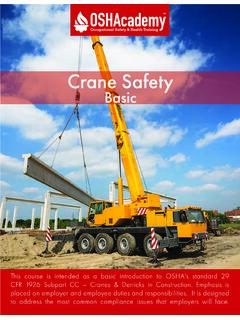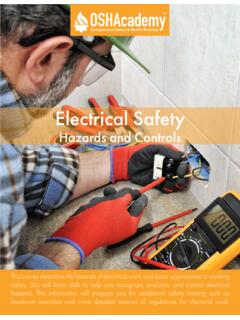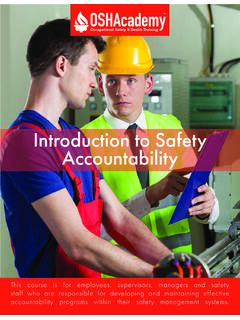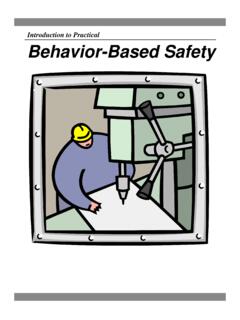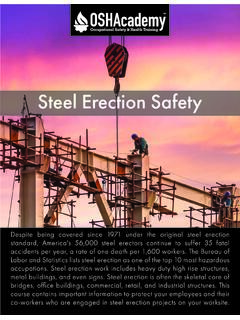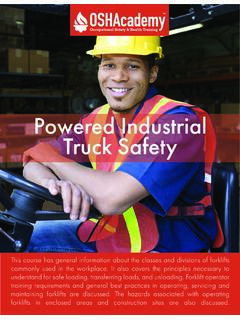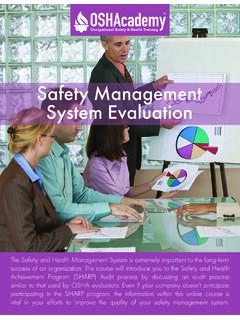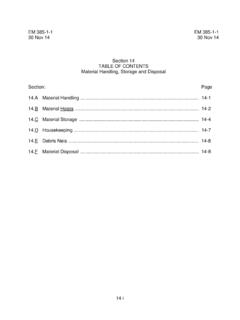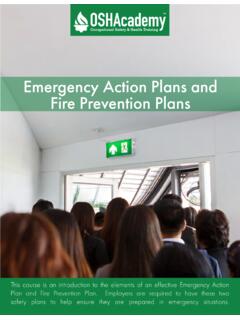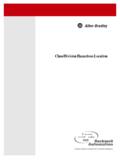Transcription of Personal Protective Equipment - OSHA Training
1 Personal Protective EquipmentBasicThis course is an introduction to the various types of Personal Protective Equipment (PPE), including eye and face protection, head protection, arm and hand protection, foot protection, body protection, and respiratory protection. The course is also one of the mandatory courses in osha cademy's 10- and 30-Hour Safety Training Programs for General Industry. This page intentionally blank osha cademy Course 108 Study Guide Personal Protective Equipment : Basic Copyright 2022 Geigle Safety Group, Inc. No portion of this text may be reprinted for other than Personal use. Any commercial use of this document is strictly forbidden.
2 Contact osha cademy to arrange for use as a Training document. This study guide is designed to be reviewed off-line as a tool for preparation to successfully complete osha cademy Course 108. Read each module, answer the quiz questions, and submit the quiz questions online through the course webpage. You can print the post-quiz response screen which will contain the correct answers to the questions. The final exam will consist of questions developed from the course content and module quizzes. We hope you enjoy the course and if you have any questions, feel free to email or call: osha cademy 15220 NW Greenbrier Parkway, Suite 230 Beaverton, Oregon 97006 +1 (888) 668-9079 Disclaimer This document does not constitute legal advice.
3 Consult with your own company counsel for advice on compliance with all applicable state and federal regulations. Neither Geigle Safety Group, Inc., nor any of its employees, subcontractors, consultants, committees, or other assignees make any warranty or representation, either express or implied, with respect to the accuracy, completeness, or usefulness of the information contained herein, or assume any liability or responsibility for any use, or the results of such use, of any information or process disclosed in this publication. GEIGLE SAFETY GROUP, INC., DISCLAIMS ALL OTHER WARRANTIES EXPRESS OR IMPLIED INCLUDING, WITHOUT LIMITATION, ANY WARRANTIES OF MERCHANTABILITY OR FITNESS FOR A PARTICULAR PURPOSE. Taking actions suggested in this document does not guarantee that an employer, employee, operator or contractor will be in compliance with applicable regulations.
4 Ultimately every company is responsible for determining the applicability of the information in this document to its own operations. Each employer s safety management system will be different. Mapping safety and environmental management policies, procedures, or operations using this document does not guarantee compliance regulatory requirements. Revised: March 28, 2022 This page intentionally blank Course 108 Contents Course Introduction .. 1 Free Training ! .. 1 Module 1: General PPE Requirements .. 2 Employer Responsibilities .. 2 Employee Responsibilities .. 2 Who Pays for PPE? .. 3 Payment Exceptions under the osha Rule .. 4 What About Safety Belts and Back Belts? .. 4 Safety 4 Back Belts .. 5 Work Clothing .. 5 Defective and Damaged Equipment .
5 5 PPE Selection - One size does not fit all.. 6 Conduct a Hazard Assessment .. 6 PPE Training (Hands-On-How-To) .. 7 Types of PPE .. 8 Eye and Face Protection .. 8 Glasses .. 8 Goggles .. 8 Face Shields .. 9 Welding Shields .. 9 Respiratory Protection .. 10 Respirator Types .. 10 Course 108 Air-Purifying Respirators (APR) .. 11 Atmosphere-Supplying Respirators .. 13 Module 2: Types of PPE .. 15 Head Protection .. 15 Criteria for Protective Helmets .. 16 Selection Guidelines for Head Protection .. 17 Impact Type Helmets .. 17 Electrical Classes .. 17 Bump Caps .. 17 Hand Protection .. 18 Glove Guide .. 18 Selection of Hand Protection .. 19 Glove Selection Chart .. 20 Foot Protection .. 22 Criteria for Protective Footwear .. 23 1.
6 Steel-Reinforced Safety Shoes .. 23 2. Safety Boots .. 23 Electrical Protective 24 Inspecting Equipment .. 24 Defects .. 24 Electrical Protective Gloves .. 25 Testing .. 26 Hearing Protection .. 27 Sound and Noise .. 27 Course 108 Hearing Conservation Program .. 27 Hearing Protectors .. 28 Additional Resources .. 30 Course 108 Copyright 2021 Geigle Safety Group, Inc. Page 1 of 30 Course Introduction This course is an introduction to the various types of Personal Protective Equipment (PPE), including eye and face protection, head protection, arm and hand protection, foot protection, body protection, and respiratory protection. Free Training ! As a registered osha cademy student, you gain free access to all Training materials, including student dashboard, online courses and study guides, module quizzes, and final course exams.
7 If you decide you would like official documentation of the Training including certificates, cards, and transcripts, we charge a small processing fee. Course 108 Copyright 2021 Geigle Safety Group, Inc. Page 2 of 30 Module 1: General PPE Requirements osha standards require the use of PPE to reduce employee exposure to hazards when engineering and administrative controls are not feasible or effective in reducing these exposures to acceptable levels. Employers are required to determine if PPE should be used to protect their workers and they must also make sure employees use and maintain PPE in a sanitary and reliable condition. Employer Responsibilities In general, employers are responsible for: performing a "hazard assessment" of the workplace to identify and control physical and health hazards; identifying and providing appropriate PPE for employees; Training employees in the use and care of the PPE; maintaining and replacing worn or damaged PPE; and periodically reviewing, updating and evaluating the effectiveness of the PPE program Employee Responsibilities In general, employees should be: properly wearing PPE, attending Training sessions on PPE, properly storing, cleaning, and maintaining PPE, and informing a supervisor of the need to repair or replace PPE Quiz Instructions After each section, there is a quiz question.
8 Make sure to read the material in each section to discover the correct answer to these questions. Circle the correct answer. When you are Course 108 Copyright 2021 Geigle Safety Group, Inc. Page 3 of 30 finished go online to take the final exam. This exam is open book, so you can use this study guide. 1. Who is directly responsible for storing, cleaning, and maintaining PPE? a. Employers b. Employees c. Safety Staff d. Supervisors Who Pays for PPE? With few exceptions, osha requires employers to pay for Personal Protective Equipment used to comply with osha standards. Employers cannot require workers to provide their own PPE. Employees who use their own PPE must do so voluntarily. Even if an employee provides his or her own PPE, the employer must still ensure the Equipment is adequate to protect the worker from hazards at the workplace.
9 Employers must pay for the following: metatarsal foot protection rubber boots with steel toes non-prescription eye protection prescription eyewear inserts/lenses for full face respirators goggles and face shields firefighting PPE (helmet, gloves, boots, proximity suits, full gear) hard hats hearing protection welding PPE Course 108 Copyright 2021 Geigle Safety Group, Inc. Page 4 of 30 Payment Exceptions under the osha Rule Employers are not required to pay for some PPE in certain circumstances: Non-specialty safety-toe Protective footwear (including steel-toe shoes or boots) and non-specialty prescription safety eyewear provided that the employer permits such items to be worn off the job site. osha based this decision on the fact that this type of Equipment is very Personal , is often used outside the workplace, and that it is taken by workers from jobsite to jobsite and employer to employer.
10 Everyday clothing, such as long-sleeve shirts, long pants, street shoes, and normal work boots. Ordinary clothing, skin creams, or other items, used solely for protection from weather, such as winter coats, jackets, gloves, parkas, rubber boots, hats, raincoats, ordinary sunglasses, and sunscreen. Items such as hair nets and gloves worn by food workers for consumer safety. Lifting belts because their value in protecting the back is questionable. When the employee has lost or intentionally damaged the PPE and it must be replaced. 2. Which of the following PPE items must the employer pay for? a. Hair nets b. Rubber boots and parkas c. Goggles and face shields d. Normal work boots What About Safety Belts and Back Belts? Safety Belts Safety belts, also called body belts, are worn around the waist to help employees working at heights correctly position themselves in front of a work area or to prevent them from falling over an edge.
